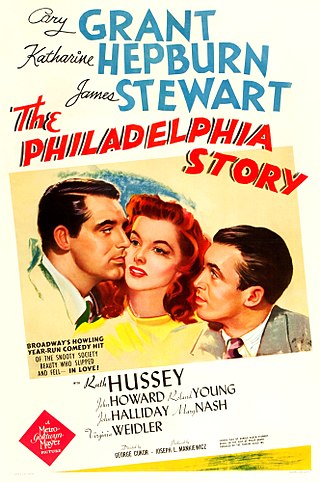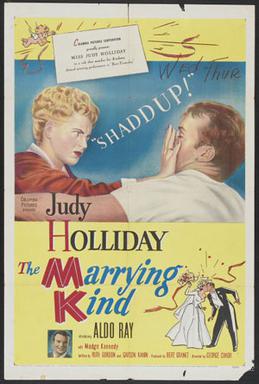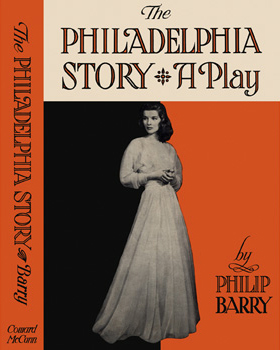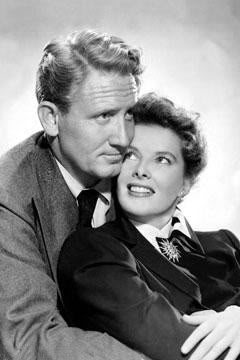
Ruth Gordon Jones was an American actress, screenwriter, and playwright. She began her career performing on Broadway at age 19. Known for her nasal voice and distinctive personality, Gordon gained international recognition and critical acclaim for film roles that continued into her 70s and 80s. Her later work included performances in Rosemary's Baby (1968), What Ever Happened to Aunt Alice? (1969), Where's Poppa? (1970), Harold and Maude (1971), Every Which Way But Loose (1978), Any Which Way You Can (1980), and My Bodyguard (1980).

Katharine Houghton Hepburn was an American actress whose career as a Hollywood leading lady spanned six decades. She was known for her headstrong independence, spirited personality, and outspokenness, cultivating a screen persona that matched this public image, and regularly playing strong-willed, sophisticated women. Her work was in a range of genres, from screwball comedy to literary drama, and earned her various accolades, including four Academy Awards for Best Actress—a record for any performer. In 1999, Hepburn was named the greatest female star of classic Hollywood cinema by the American Film Institute.

Spencer Bonaventure Tracy was an American actor. He was known for his natural performing style and versatility. One of the major stars of Hollywood's Golden Age, Tracy was the first actor to win two consecutive Academy Awards for Best Actor from nine nominations. During his career, he appeared in 75 films and developed a reputation among his peers as one of the screen's greatest actors. In 1999, the American Film Institute ranked Tracy as the 9th greatest male star of Classic Hollywood Cinema.

The Philadelphia Story is a 1940 American romantic comedy film directed by George Cukor, starring Cary Grant, Katharine Hepburn, James Stewart, and Ruth Hussey. Based on the 1939 Broadway play of the same name by Philip Barry, the film is about a socialite whose wedding plans are complicated by the simultaneous arrival of her ex-husband and a tabloid magazine journalist. The socialite character of the play—performed by Hepburn in the film—was inspired by Helen Hope Montgomery Scott (1904–1995), a Philadelphia socialite known for her hijinks, who married a friend of playwright Barry.

Adam's Rib is a 1949 American romantic comedy-drama film directed by George Cukor from a screenplay written by Ruth Gordon and Garson Kanin. It stars Spencer Tracy and Katharine Hepburn as married lawyers who come to oppose each other in court. Judy Holliday co-stars as the third lead in her second credited movie role. Also featured are Tom Ewell, David Wayne, and Jean Hagen. The music was composed by Miklós Rózsa, and the song "Farewell, Amanda" was written by Cole Porter.

Woman of the Year is a 1942 American romantic comedy-drama film directed by George Stevens and starring Spencer Tracy and Katharine Hepburn. The film was written by Ring Lardner Jr. and Michael Kanin, and produced by Joseph L. Mankiewicz.

A Double Life is a 1947 American film noir which tells the story of an actor whose mind becomes affected by the character he portrays. It stars Ronald Colman and Signe Hasso. It is directed by George Cukor, with screenplay by Ruth Gordon and Garson Kanin. Ronald Colman won the Academy Award for Best Actor for his performance in this film.

Edward, My Son is a 1949 British drama film directed by George Cukor for MGM-British Studios that stars Spencer Tracy and Deborah Kerr. The screenplay by Donald Ogden Stewart is based on the 1947 play of the same title by Noel Langley and Robert Morley.

Judy Holliday was an American actress, comedian and singer.

Garson Kanin was an American writer and director of plays and films.

The Marrying Kind is a 1952 American comedy drama film directed by George Cukor and starring Judy Holliday and Aldo Ray. Other cast members include John Alexander, Charles Bronson, Peggy Cass, Barry Curtis, Tom Farrell, Frank Ferguson, Ruth Gordon, Gordon Jones, Madge Kennedy, Nancy Kulp, Mickey Shaughnessy, and Joan Shawlee.

Born Yesterday is a 1950 American comedy-drama film directed by George Cukor, based on the 1946 stage play of the same name by Garson Kanin. The screenplay was credited to Albert Mannheimer. According to Kanin's autobiography, Cukor did not like Mannheimer's work, believing it lacked much of the play's value, so he approached Kanin about adapting a screenplay from his own play. Because of legal entanglements, Kanin did not receive screen credit.

Keeper of the Flame is a 1942 American drama film directed by George Cukor, and starring Spencer Tracy and Katharine Hepburn, released by Metro-Goldwyn-Mayer (MGM). The screenplay by Donald Ogden Stewart is adapted from the 1942 novel Keeper of the Flame by I. A. R. Wylie. Hepburn plays the widow of a famous civic leader who has died in an accident. Tracy portrays a former war correspondent who intends to write a flattering biography of the dead man, only to find that his death is shrouded in mystery. Screenwriter Stewart considered the script the finest moment of his career, feeling vindicated by the assignment as he believed that Hollywood had punished him for years for his political views. Principal filming began in the last week of August 1942, four months after the release of the novel, published by Random House. The picture was filmed on a sound stage, with no location shooting. Hepburn had already begun a relationship with Tracy, and his heavy drinking led her to become his vigilant guardian during the filming.
The comedy of remarriage is a subgenre of American comedy films of the 1930s and 1940s. At the time, the Production Code, also known as the Hays Code, banned any explicit references to or attempts to justify adultery and illicit sex. The comedy of remarriage with the same spouse enabled filmmakers to evade this provision of the Code. The protagonists divorced, flirted with strangers without risking the wrath of censorship, and then got back together.

Phyllis Povah was an American stage and film actress.
Michael Kanin was an American director, producer, playwright and screenwriter who shared an Academy Award with Ring Lardner Jr. for writing the Katharine Hepburn-Spencer Tracy film comedy Woman of the Year (1942).

William Brooks Ching was an American character actor who appeared in numerous films and on television during the later 1940s and 1950s. Ching may be best known for his supporting role in Rudolph Maté's 1950 film noir D.O.A. along with his role as the overbearing boyfriend of Katharine Hepburn's character in George Cukor's 1952 comedy Pat and Mike.

The Philadelphia Story is a 1939 American comic play by Philip Barry. It tells the story of a socialite whose wedding plans are complicated by the simultaneous arrival of her ex-husband and an attractive journalist. Written as a vehicle for Katharine Hepburn, its success marked a reversal of fortunes for the actress, who was one of the film stars deemed "box office poison" in 1938.

The Scarlett O'Hara War is a 1980 American made-for-television drama film directed by John Erman. It is based on the 1979 novel Moviola by Garson Kanin. Set in late 1930s Hollywood, it is about the search for the actress to play Scarlett O'Hara in the much anticipated film adaptation of Gone with the Wind (1939). This film premiered as the finale of a three-night TV miniseries on NBC called Moviola: A Hollywood Saga.

Katharine Hepburn (1907–2003) and Spencer Tracy (1900–1967) were a legendary cinematic couple, both on- and off-screen. They starred in nine films together, and had an affair—an open secret in Hollywood—that lasted 26 years, ending only with Tracy's death.

















